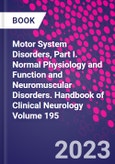Table of Contents
Section 1. Normal Physiology and Function
1. Skeletal muscle structure, physiology, and function
2. Upper and lower motor neuron neurophysiology and motor control
3. Vestibular motor control
4. Autonomic failure: Clinicopathologic, physiologic, and genetic aspects
5. Gait control by the frontal lobe
6. Parietal control of hand movement
7. Immunology and microbiome: Implications for motor systems
8. COVID-19 (novel SARS-CoV-2) neurological illness
Section 2. Clinical and Laboratory Diagnosis
9. Neurogenetic motor disorders
10. Neuromuscular electrodiagnosis
11. Quantitative electrodiagnosis of the motor unit
12. Neuromuscular pathology
13. Electrophysiological assessment of peripheral and central autonomic disorders
14. On the path to evidence-based therapy in neuromuscular disorders
15. Advances in the neuroimaging of motor disorders
16. Sleep-related motor disorders
Section 3. Neuromuscular Disorders
17. Neonatal and infantile hypotonia
18. Autoimmune inflammatory myopathies
19. Childhood muscular dystrophies
20. Distal myopathy
21. Muscle channelopathies
22. Congenital myopathies
23. Mitochondrial encephalomyopathy
24. Autoimmune polyneuropathies
25. Hereditary neuropathy
26. Acute/chronic inflammatory polyradiculoneuropathy
27. Myasthenia gravis and congenital myasthenic syndromes
28. Adult and childhood vasculitis
29. Critical illness-associated weakness and related motor disorders








